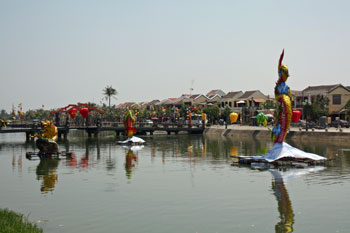 I spent 17 wonderful days in Hoi An and it was easily my favorite city in Vietnam so far. One strange thing I discovered was that people tend to either love or hate Hoi An, without much in the middle. I have some guesses as to why some of these morons seem to dislike the place, and they are mostly centered around where you stay in the city.
I spent 17 wonderful days in Hoi An and it was easily my favorite city in Vietnam so far. One strange thing I discovered was that people tend to either love or hate Hoi An, without much in the middle. I have some guesses as to why some of these morons seem to dislike the place, and they are mostly centered around where you stay in the city.
Normally I will pay a premium to stay in a central location. I’ll be happier with a 1-star hotel in the city center instead of a 3-star hotel a ways out of town, even if they are the same price. I normally just don’t like staying in far-flung suburbs and feeling like it’s a major trek to reach the area that I’ve come to see in the first place, but in Vietnam, at least for me, I’m changing my mind on that.
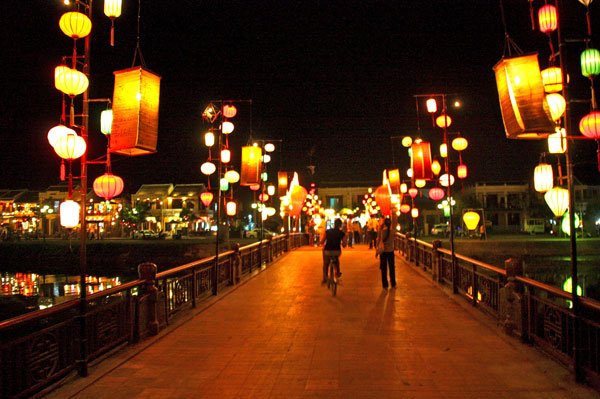
I’ve heard lots of complaints from tourists to countries like this, and I’ve made some of those complaints myself, about the relentless offers from souvenir merchants and taxi drivers and god knows who else that is looking at you like a wallet on two legs. It seems to be a universal problem in countries where the tourists all have more money than 99% of the locals. Vietnam is definitely one of those countries, and evidently it’s possible to make an okay living hounding tourists, even though there are thousands of other people doing the exact same thing.
Hoi An’s unique old town
The specific deal with Hoi An is that it has this fairly large section near the river that looks like a Chinese fishing village of yore, and it’s so well preserved that the whole thing is a UNESCO World Heritage site. Many people describe that area as Disneyland-esque and that’s not too far off the mark, but on the other hand it all looks very authentic and it’s definitely not a brand-new recreation of a village so if anything Disneyland is built to look like places like this.
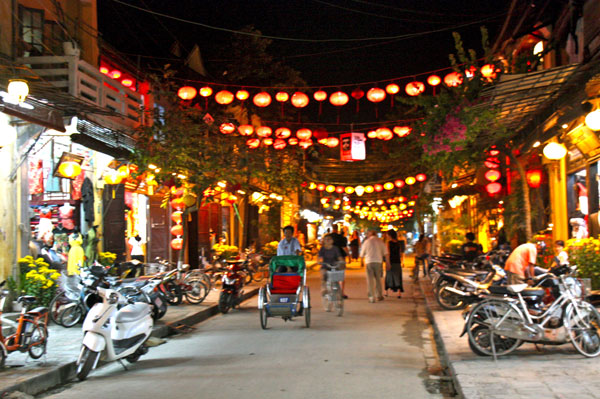
It really is beautiful, and another bonus is that for many hours on most days it’s free of motorized vehicle traffic. That you can walk through this area only joined by bicycles and other tourists is really lovely.
There are a few dozens restaurants in this old town area, plus another dozen or more right along the river that runs through town. The food in Hoi An is amazing, but we’ll get to that a bit later.
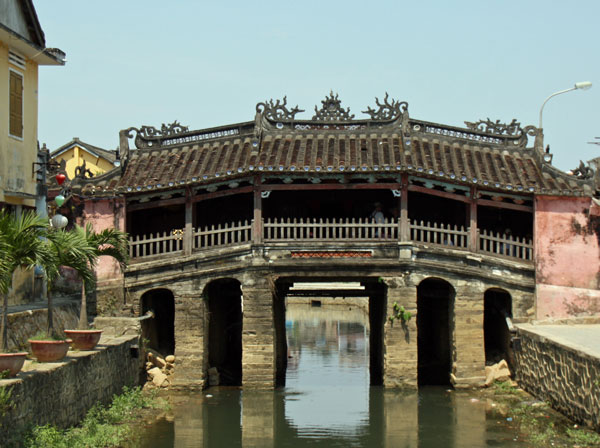
As far as I can tell, most of the people who dislike Hoi An are those who stayed right in or very near the old town, and most of the people who love it seemed to stay in the tourist/backpacker districts a bit outside of the historic area. I think the problem tends to be that those who stay in the historic area never leave it, since it’s where most of the attractions are, as well as more great restaurants than anyone could try on one trip. But those who stay a bit away from that are more or less staying in the “real Vietnam” so they get to experience both styles, and don’t get burned out so quickly.
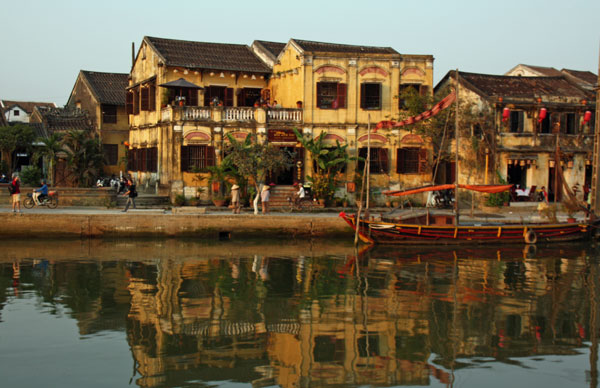
There are excellent restaurants all over the place and in the 17 days I was there I probably only ate in the old town area maybe 10 times or so. I should also point out that I was working on my new website in my comfortable $10/night hotel room for much of the time, so I only did touristy things on maybe half of the days I was in Hoi An.
Hoi An is famous for its tailor shops
I’d read about this before I got to Hoi An, but it was still surprising to see how huge the industry is when I arrived. The city has 200 tailor shops that are ready to make you nearly anything you can think of in about a day, for far less than it would cost in a store. I read you can get proper business suits starting around $100, and shirts and dresses etc starting around $10.
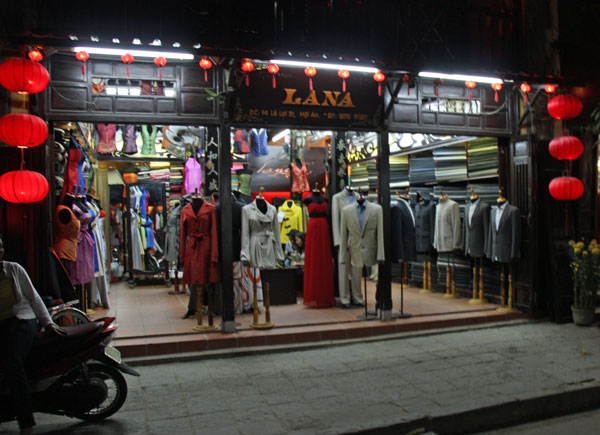
Since I’m traveling with a fairly full backpack and I have no official home at the moment I really had no interest in having anything made for myself. The one upside for me is I could actually get something that fit me, which really isn’t possible in stores in Vietnam. I’m probably 8 inches taller than the tallest Vietnamese men I’ve seen, and about twice as wide too.
If you research the tailor shop topic you’ll find that there are many people who love their purchases as well as many people who feel ripped off by either being overcharged or getting seriously flawed and cheaply made garments. Evidently it’s yet another one of those things in Vietnam where you kind of have to take your chances and hope for the best.
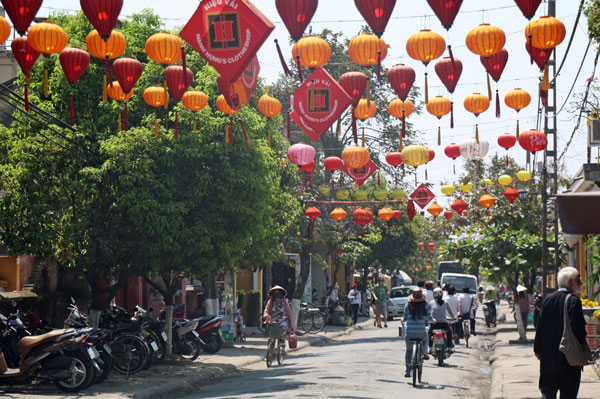
The area where these 200 tailor shops is has maybe 600 or 700 businesses altogether, so you really can’t go more than half a block without seeing one, and a few streets are completely lined with them. A few of them make shoes instead, but most of them dealt with fabric and they all looked exactly alike from the outside.
It’s also clear that they don’t actually make the clothes in or near the shops, which kind of surprised me when I noticed this. I had imagined that there would be samples and books and fabric swatches in front and an army of sewing machines in the back, but it seems that these shops just take the orders and then subcontract to a local sweatshop that actually makes the thing. I walked by one of those sweatshops that’s door was open and inside I saw at least 10 people sewing away.
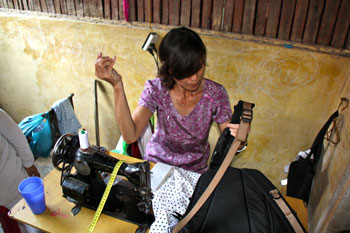 The closest I came to having something made was when I found a seamstress in the back of the food market and had her sew up the strap on my daypack that had seriously frayed and was a few days away from coming apart completely. She repaired it nicely, but it didn’t look as slick as I expected. She asked for $2 and I’m sure I could have bargained her down to $1 but I didn’t bother and I gave her 40,000 dong, which is about $2.20. From what I hear that is the typical daily wage in Vietnam, so she probably made as much in 10 minutes from me as she did the rest of the day.
The closest I came to having something made was when I found a seamstress in the back of the food market and had her sew up the strap on my daypack that had seriously frayed and was a few days away from coming apart completely. She repaired it nicely, but it didn’t look as slick as I expected. She asked for $2 and I’m sure I could have bargained her down to $1 but I didn’t bother and I gave her 40,000 dong, which is about $2.20. From what I hear that is the typical daily wage in Vietnam, so she probably made as much in 10 minutes from me as she did the rest of the day.
Highlights of Hoi An
I’m already rambling too much and I haven’t even mentioned anything I did so I’m going to just hit the highlights below. Again, I was working much of the time I was in Hoi An so I probably could have done all these touristy things in about 5 days if I wanted to, but I’m glad I didn’t rush like that.
The awesome food of Hoi An
I’m planning on writing another whole post about food highlights of the country, so I won’t get too specific on some of that here. Suffice to say, Hoi An is the best food city in Vietnam, and among the best in Asia or in the world for that matter. It’s tropical and far enough south that it seems they can grow just about anything year round. The main food market is enormous and kind of a tourist attraction unto itself, so it has a weird combination of ridiculous souvenirs and fresh food.
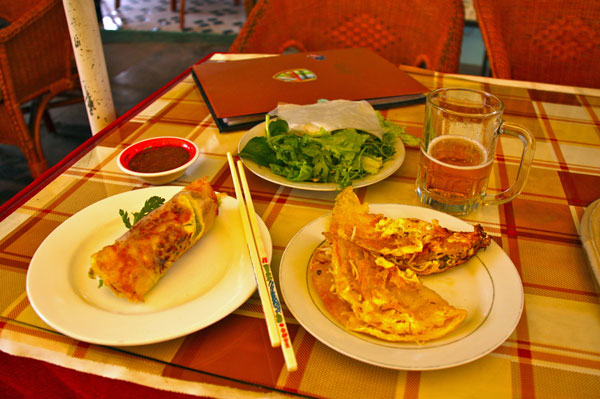
Speaking briefly about the souvenirs, the single most popular thing you see on t-shirts is the phrase “Good Morning Vietnam” and that’s also the name of a chain of well-regarded Italian restaurants in this country. I guess it is one of the most famous things that uses the word Vietnam in it, so it’s better than t-shirts that just say “Vietnam War” on them. That war is called “The American War” here, by the way.
Back to the food, I’m not sure exactly why Hoi An is the good-food capital of Vietnam, and actually Hue, which isn’t far away, had great food too, but this place is in a league of its own. It could be that the city attracts more “cultural tourists” than most other nearby cities. Honestly the one city that Hoi An reminds me of is New Orleans. They don’t look much alike. It’s mostly that both cities are very touristy and yet very cool at the same time. They both have excellent food and that adds to the similarities.
One thing about Southeast Asia and food in general is that refrigeration, from what I’ve read, has only come to this area in the last 20 years or so. It’s hot as hell here nearly all the time so buying and running a refrigerator probably isn’t cheap, and for most things they don’t really need it anyway.
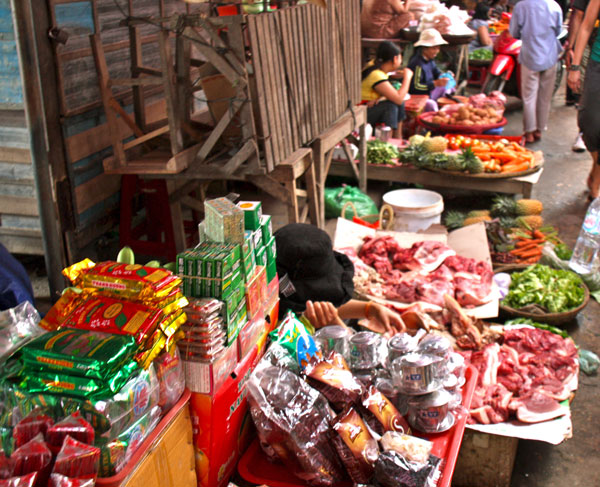
Imagine if there was a farmer’s market a few blocks from your house and everything there was in peak season all year round, and also everything was grown within 10 miles of the market, probably organic, and picked less than 24 hours before it went on sale. Also imagine that everything at the market was so cheap that it might as well be free. This seems to be the case in much of Vietnam, and definitely in Hoi An.
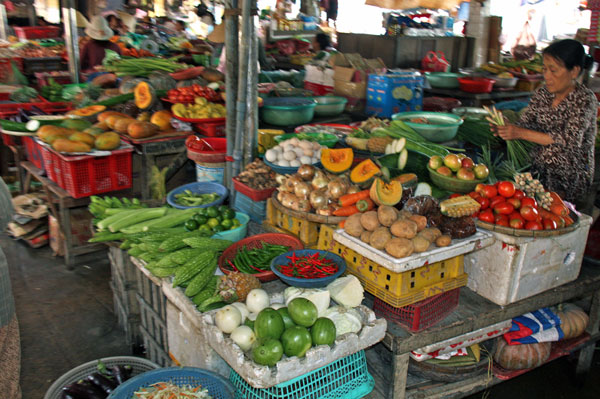
Another way of thinking about it is, if you were going to prepare a complicated dish that had 5 or 6 different vegetables and herbs in it, and you went to Whole Foods to get the best quality you could find, it might cost $10 or more. If you wanted to make the same thing here it might cost $1 for those same things, and they’d be at least a day or two fresher as well. This helps explain why the food here is so amazing and so cheap at the same time.
There are a couple of local dishes only made in Hoi An, namely a pork and noodle dish called cao lau, and an elegant shrimp dumpling dish called white rose. Legend has it that both are made only from water from a specific well, so it’s pointless trying to recreate them elsewhere. I tried both and really liked them, and I had cao lau on many occasions in fact. It’s a hearty dish that is topped with fresh greens, and a decent size portion costs between 75 cents and a dollar even at fancy places.
The banh mi sandwich incident
This might be my fondest memory so far in Vietnam, and it’s probably the best single story so far too. I actually wrote the whole thing on my new site, about the best banh mi sandwich in the world, so check that out and you can see all the photos and such.
The short version is on the show No Reservations with Anthony Bourdain they visited Vietnam on a memorable episode. Much of it takes place in Saigon, but about halfway in they fly to Danang for a short stay in Hoi An. Tony and his old French boss who has accompanied him visit the local market and have breakfast, and at some point someone tells them about the best place to get a banh mi sandwich there.
After breakfast they find the small sandwich stall and order one to share. The video of that segment is embedded near the top of the full story on my other site, and it’s 90 seconds well spent if you want to understand the story. The sandwich looks amazing so I had to look around to find this exact place.
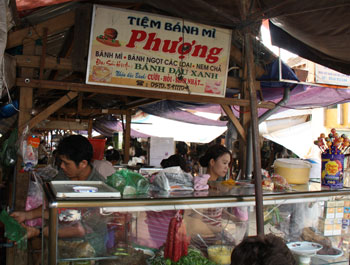 On my second try I found it, and I had a sandwich that was really good, but not quite like the one on the show. I went back the following day and I had my iPhone with me, on which I had saved the video from the show. It was a different woman making the sandwiches this day, and it turned out this was the one in the video.
On my second try I found it, and I had a sandwich that was really good, but not quite like the one on the show. I went back the following day and I had my iPhone with me, on which I had saved the video from the show. It was a different woman making the sandwiches this day, and it turned out this was the one in the video.
At first she asked me if this video was made by a friend of mine. Evidently her first thought was that this was just a home video of a friend, although she must have noticed the large camera, sound man, and producer along with the two on-camera guys. Anyway, this was the first time she’d seen this footage and she loved watching it. She called a friend over and had me play it again, and that went over well as you might expect.
In the following days I went back there a few more times and a couple of those visits she had me show the video to yet another nearby friend and I could tell how tickled she was by this. Starting on my second visit I got the ‘banh mi deluxe” version with the egg on top and they were awesome, plus only 75 cents each.
Visiting the My Son temple
The Cham people (I’d never heard of them either) lived here for like 1,500 years, only disappearing about 200 years ago, I believe. Their legacy seems to be mostly gone, but there are a few various temples, or ruins of temples, dotted around the countryside. The largest (I believe) and most famous of these are called My Son (pronounced ‘Mee Sen’) and they are about 30 miles outside of Hoi An. You can get a bus tour that takes you there, along with an “English speaking” guide for around $6, but then you have to pay $3 more to actually get into the My Son complex.
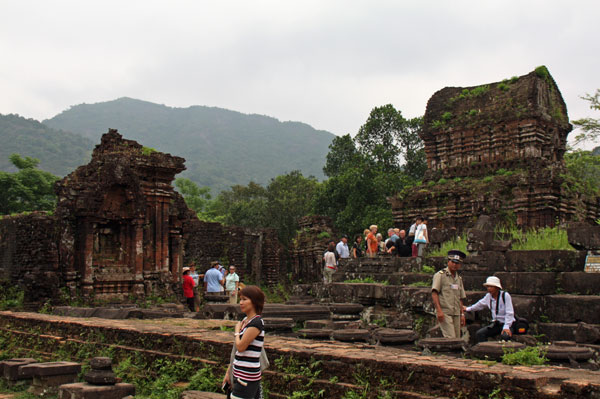
Of course I eventually did one of these tours, and it reminded me of how much I dislike packaged tours in that sense. A huge bus pulled up in front of my hotel a bit after 8am and then it stopped at about 10 other hotels in the area until every last seat was taken. The guide was a local guy who did speak English, but as usual it was hard to understand him much of the time, and beyond his prepared speeches it seemed like his English really tailed off quickly. He was a nice enough guy, though his presentation wasn’t really all that informative, partly because his accent was very thick so it was impossible to understand every word he said.
After about an hour since packing the bus full we arrived at the temple complex. We first had a 15-minute stop at a large souvenir shop that also had a restaurant inside, and these inevitable stops are nice as a bathroom break, but they also tend to be a big waste of time. The tour company gets about a 20% commission on any overpriced souvenirs that the group buys, so these shops are included on every single tour you can find, unless maybe it’s a high-priced tour through a posh hotel, but even then I bet they have to stop at these places.
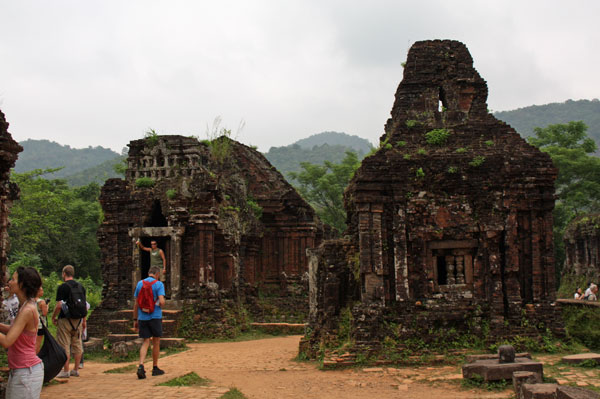
Once we finally got to the temple at around 10am I realized that I probably should have done the early morning version. Not only was it hot and humid as could be already, but the way these ruins are laid out means that tour groups are literally crawling all over them all day, so pretty much any photo you might take is partly filled with other tourists posing for their own shots, or just climbing up and down the temples themselves. It’s a beautiful place that reminded me a bit of Tikal in Guatemala, though this is much, much smaller.
A British/Canadian guy I spoke to several times at my hotel told me he took the early morning version. That tour left at 5:30am, which is about an hour before dawn, so you get there as the sun is rising. The guy told me it was just he and another guy in a private car, and once at the ruins they were pretty much alone as well. On my bus trip we were treated only a little better than cattle, and the mass of fellow tourists at My Son pretty much ruined most of its charm as well.
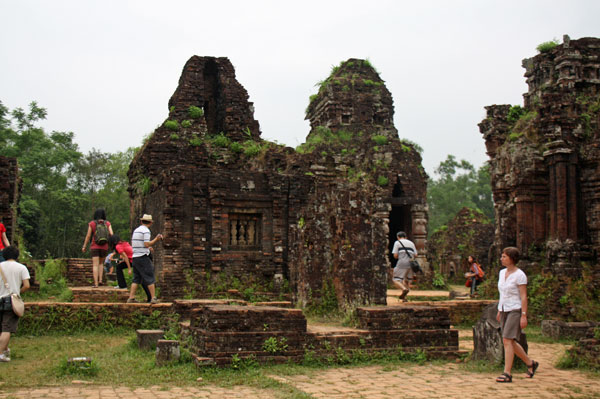
I had originally paid only $6 and intended to come right back on the bus, but shortly after I boarded the guide convinced me that I should pay $3 extra to return by boat, with lunch included. This turned out to be a mistake.
The bus drove at least halfway back to Hoi An before we got to the boat. About two-thirds of the people on the bus also did the boat portion, so I was far from alone, but still it pretty much sucked. The lunch was a small plate of rice with a few vegetables and a scrambled egg on top, so it was maybe a 25-cent value by Hoi An standards, and also not very good.
The scenery on the boat was disappointing as well. It turns out it’s a wide and muddy river when you get outside of Hoi An, and from the boat you could only vaguely see rice fields on each bank. The weirdest thing about the trip for me was that a Chinese girl sitting right in front of me videotaped almost the whole boat ride. I feel sorry for her friends and family when she tries to get them to watch it later on.
Before getting back to Hoi An we stopped at another nearby island that is known for wood carving. In theory this would have been nice, but in reality our guide herded us directly into the “showroom” of one of these carving shops, where he’d obviously get a commission if anyone bought anything. The rest of our time on the island was spent going to two other nearly identical showrooms that were each only a few meters away from the first one, and then we were herded back onto the boat for another 10-minute cruise to Hoi An.
If you are going to Hoi An yourself, do the early morning trip to My Son, and skip the idiotic boat ride.
Enjoying the world’s cheapest beer
Since my new website is based on the prices of things for travelers, I felt obligated to investigate what seems to be the cheapest beer in the world. I mentioned “bia hoi (fresh beer)” in Hanoi, but there it’s more of a novelty than anything else. In Hoi An you can actually find a better version of the stuff offered up at some of the nicest restaurants in town.
It costs between 3000 and 5000 dong, which is between 16 and 26 cents per glass, and the stuff is served cold and it’s quite good. My favorite restaurant called Café 43 got a fresh keg of the stuff every morning and it would be polished off by that evening, often with my help.
I explained more about it in the article linked above so I won’t repeat it all here.
A cooking class
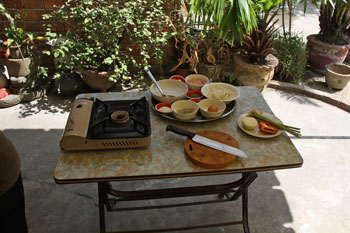 Another article I wrote for my other site is about taking a cheap cooking class in Hoi An. It seems that at least half the restaurants in the city offer a cooking lesson of some kind, almost all by appointment only. I’d read that many of them are half-day or even a full day, and those start at around $25 and go up from there. That’s definitely not a bad price for a 4-hour class, but when you are paying $10 a night for a nice hotel it seems like a bit much.
Another article I wrote for my other site is about taking a cheap cooking class in Hoi An. It seems that at least half the restaurants in the city offer a cooking lesson of some kind, almost all by appointment only. I’d read that many of them are half-day or even a full day, and those start at around $25 and go up from there. That’s definitely not a bad price for a 4-hour class, but when you are paying $10 a night for a nice hotel it seems like a bit much.
So I eventually discovered that Café 43 gave cooking lessons for $5 plus the cost of the dishes you prepare. I wrote the whole story and included loads of photos in that article linked just above in case you are interested. I’m now looking forward to a time when I have a kitchen again so I can make it for myself at home. Perhaps when I get to Bangkok I’ll rent an apartment in which I can give it a try, and it’ll be extra nice there since the ingredients will be easy to find and cheap too.
Renting a motorbike for a day
The last story I’ll relate about Hoi An was one of the highlights of my whole trip so far. Motorbikes rule the roads here but I normally prefer to walk anywhere I can. Unfortunately, the sidewalks here are almost always used for motorbike parking so walking often means doing so in the street, dodging a bit of traffic as you go.
You can rent motorbikes easily and cheaply here, but I never really had a good reason to do it, other than just cruising around for a day. So in Hanoi I did exactly that. For $5 I rented an automatic (manuals are only $3 per day) motorbike, along with a helmet big enough to fit my oversized noggin. The bike was really fast and powerful, even to the point that I didn’t dare riding near full speed even on the open road.
Hoi An is about 2 miles from a rather nice beach, and except for briefly seeing it as I rode in a taxi on the way in, I hadn’t seen it. So my first stop was the close beach and then a tour of some of the new resorts just a bit down from the public part of the shore.

I then drove down a dirt path that a really good SE Asia website said would lead me to a temple and a vegetable farm, but I never found those things. Still, it was really lovely to be free to zoom around and see anything I wanted after being in the town for so long.
After going back to my hotel briefly I started out again toward Marble Mountain, which I’d seen on the drive in, since it’s close to Danang where my train dropped me off. On the taxi ride to Hoi An the driver asked me if I wanted to stop at Marble Mountain to take photos and I said no. He stopped anyway, promising it was a free bonus on the ride, but of course he pulled up in front of one of those large souvenir depots, this one filled with marble statues and figures. I looked around for about 30 seconds and then used their restroom and I was back on my way, but in that short time I could clearly see this Marble Mountain was all about souvenirs.
So now on the motorbike I got directions from 3 different people about how to get there, and each said to go a different way. The 12-mile road I ended up taking was probably the fastest, but instead of going along the beach as I’d imagined I was on the main road that was basically one small village after another. This turned out to be very interesting since the villages probably get zero tourism so I could see what Vietnam is like when they are just selling things to each other instead of trying to sell them to tourists. It turns out it looks pretty much the same.
The road suddenly got wide and modern as I neared Marble Mountain, and when I was about a mile away a woman rode up along side me and asked where I was going. I told her I was headed to the mountain I could clearly see in front of me, and she offered to show me the exact way there. Her English was quite good so I already knew what was about to happen, but I appreciated the way she approached me offering to help so I went along with it.
She showed me a somewhat hidden road that took us to the base of the mountain, and then she waved me to park in front of what she admitted was her family’s marble store. She showed me where to take the best photos of the structures up on the mountain and then offered to show me where to go if I wanted to walk up the thing, but this was motorbike day so I was fine just taking photos from the base.
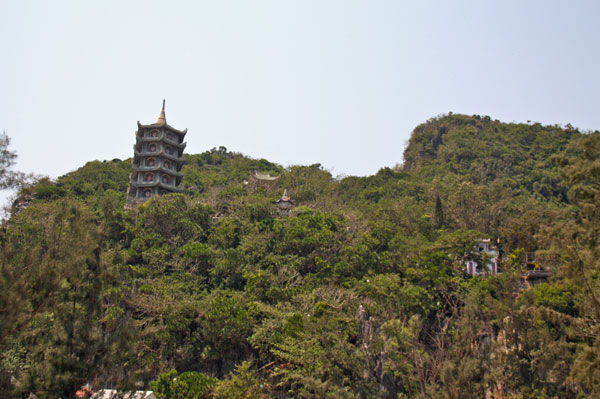
After that she insisted I take a look at the various statues and tchotchkes they had and it was all impressive. I explained to her that I’m traveling indefinitely with only a backpack so I can’t buy anything. That line doesn’t work on most merchants here and it didn’t work on her either. She showed me some very small items, including one that I rather liked.
Long story short, I ended up buying what could either be an incense holder or a toothpick holder (they have toothpicks everywhere in this country, no joke, and incense everywhere too) made of what appears to be white marble. I assume it is, since the mountain itself is supposedly a big marble mine of sorts. After a spirited negotiation that included me walking away twice, I ended up paying $5 for the thing. She told me it took her father a full day to make it, and even though that might be BS, the average wage here seems to be around $2 per day, so it’s possible.
After Marble Mountain I drove back to Hoi An along China Beach (the one that TV show was named after), which is the same route my taxi took when I first arrived. Interestingly, the long sandy beach is lined with a few international resort hotels, plus a whole bunch more being constructed currently. Evidently this China Beach area will soon be a fancy hotel area like Nusa Dua in Bali, although it remains to be seen how many people will want to spend $200 per night in Vietnam. There are definitely a lot of pricey and fancy hotels in each city, so it just might work.
Once I got back to Hoi An I looked at my map again and realized I had never seen what was south or west of the city so I set out along the main roads to check it out. I was kind of just driving for the sake of driving, but it was very nice. I stopped frequently to take photos of weird statues or signs or of rice fields that had really lovely colors.
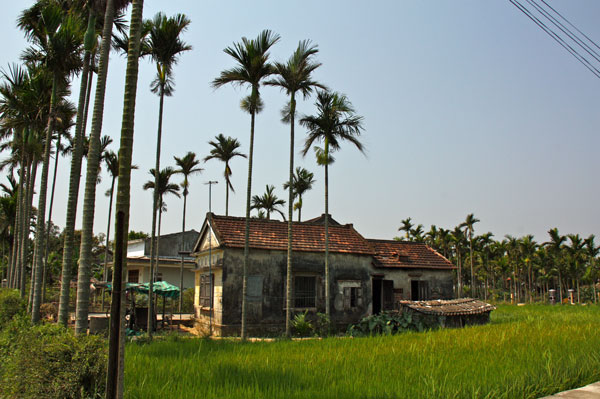
It was also kind of interesting to see what basically amounts to the “suburbs” in Vietnam. On Google Maps you see a city and then a long road that leads to another town, and you might expect it to be empty in between. But in Vietnam it seems that almost all of these roads are actually lined with homes and shops so you almost never really feel in between towns. I’m sure in the rural parts of the country there are plenty of open spaces. From what I’ve seen out the train windows the country is more than half rice fields, and some of those are actually close to the city centers as well.
Eventually I felt like I’d seen everything I could see in the area so I brought the motorbike back to my hotel and gave the keys to the rental guy whose shop is only two doors away. With virtually no stoplights it really is wonderful and liberating to be riding along in such a beautiful country going at any pace you like. I now have a better appreciation for why people love to ride Harleys up and down the coast of California, and if they weren’t so dangerous I’d consider doing that myself some day.
After spending 17 days in Hoi An it felt like time to move on, so I took the train to Nha Trang, which is a beach resort city about 300 miles to the south, and is where I’m writing this now.
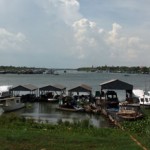
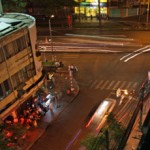

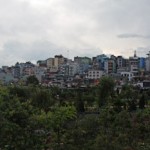
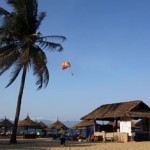
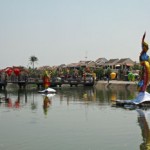
applause. You’ve done it. I am truly gearing up for a trip to your new part of the world. Okay, gearing up in the very slow sense. Late 2010ish, I hope. But still. Thanks for a peek into your 17 days. Looking forward to much more from you!
wishing you well!
Insightful overview. The point to Hoi An is that it is a place to holiday, eat well, goof off. It will appeal to travellers who want to chill out without hassle. Far better place to hang out than say Nha Trang.
Thanks for your long and loving tribute to Hoi An. My husband and I returned from Vietnam about two weeks ago with one regret: Not enough time in Hoi An. You’ve brought it alive again for us.
Thanks for the informative write up! It was nice to read a frank review.
I am an expat living in the UK and have not been back to vietnam for ages. Good read.
Enjoyed your blog. Decided to cross Dalat off our itinerary, ditto for Nha Trang (I can’t do the beach thing and avoid sunbathing like the proverbial vampire.) But will spend time in Hoi An. Nice write up.
Great commentary on Hoi An! When I first saw you spent so long there, I wondered what you did all that time. But I can see how there is a lot to do around the area, plus it would be nice just as a place to live temporarily and get some work done.
My downside on Hoi An, which I think you addressed somewhat, is the tourist trade. The only issues I’ve had in six weeks in Vietnam were in Hoi An; one with a hotel owner who refused to take credit cards and shouted at me for not having cash (despite his hotel’s website saying MC/Visa were accepted), and a taxi driver I gave explicit instructions to, who then tried to scam an extra 90k.
It’s been awhile since I’ve been in another country and had the Seinfeld-esque “you’re a very, very bad man” with finger wagging. It happened twice on my last day in Hoi An.
That said, the people in Hoi An were great. Glad you got to get out of the city and see some of the other stuff.
I love your blog. Your pictures are so biutuefal. My partner and I are currently teaching in South Korea and soon we will be traveling in SE Asia. Your blog and pictures excite and inspire me.